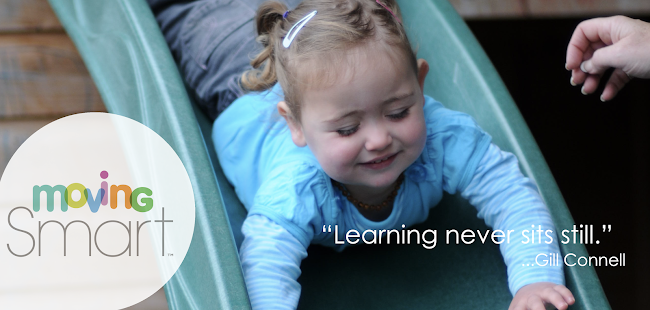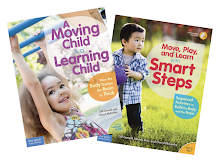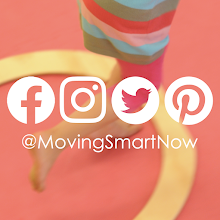Beyond the five senses we learn about in school (sight, sound, smell,
taste, and touch) there are actually two more: the vestibular system (sense of
balance) and proprioception (our intuitive sense of space and position).
Now, I realize these may not be words you’re familiar. So you might be
surprised to hear that the vestibular system and the proprioceptive sense make
possible just about everything we do (even sleeping). And they do so without
our notice. That’s because, as adults, we’ve had years of experience with these
senses so they are automatic to us.
But they are NOT automatic to kids. Like the other five senses, kids need
to learn what these senses are trying to tell them through the trial-and-error
process of everyday living, playing, and moving. And because they guide and govern how
we use our bodies, the vestibular and proprioceptive senses contribute to every major milestone and are often behind those fall-down-and-go-boom moments.
So, let’s take a quick tour these two not-so-well-known senses…
SENSE #6 – THE VESTIBULAR SYSTEM (BALANCE)
The vestibular
system is the scientific term for our sense of balance, responsible for keeping
us upright and in balance. And if you think about it, without balance, we
pretty much couldn’t do anything. For instance, if you’re reading this sitting
down, your vestibular system is keeping you upright and in the chair. Now, you
might be thinking the chair is keeping you upright, but in fact, if your brain
didn’t understand which way was up, you’d tip right over. And notice how you
don’t have to THINK about staying upright. Your vestibular system is doing it
for you automatically, every day, 24 hours a day.
Conversely, kids are focused on their balance a lot. Have you ever
noticed when a child sits in a chair he fidgets around? Yes, sometimes he has
to go to the bathroom, but quite often, what you’re seeing is his vestibular
system at work with his body, helping him adjust himself to feel in balance. In
fact, whenever a child moves (on or off the chair, indoors or out, fast or
slow, right-side up or upside down, etc., etc.), his inner ear reacts to and
records those movements, giving his brain important information about the
body’s orientation at any given moment. Over time and with lots of different
kinds of movement, his brain will begin to determine what is and isn’t “in
balance” for him.
SENSE #7 – PROPRIOCEPTION (SPACE & POSITION)
Proprioception,
or what I call Intuition, is our body and brain working together to understand
and navigate space and objects. Again, for adults this is automatic and intuitive.
Without thinking about it, you know if your body will fit through a passageway.
You climb stairs without looking at them. You have a sense of how much strength
you need to push open a door. And you don’t fall out of bed at night. Your
proprioceptive sensors (residing in your muscles, tendons, and ligaments) have
helped you develop these navigation skills over many years of practical,
everyday movements and experiences with space and objects.
A child, of course, is less experienced so so it's not automatic yet. We can guide him, but only to a point. That’s because the only way for a
child to truly know his own body is to use it. And yes, that includes
bumping into furniture, tripping over his own feet, pushing too hard, and all
those other things we think of as kid-clumsy. It’s just his body and brain working
together to learn about his environment using his proprioceptive senses to pave
the way.
WHY IS HE STILL CLUMSY?
Parents often ask me when kids will stop being so clumsy. Surely, if they
can walk, run, and jump, they must have mastered these senses by now?
Well, of course, those physical capabilities are signs of his maturing
vestibular and proprioceptive senses. But he’s not done yet for one simple
reason… he’s growing. As the body changes, the brain needs to readjust its
understanding of balance, orientation, and of course, space. And that will
take all of his growing years. For instance, the play tunnel he could walk
through last year, he has to duck down to get through this year. Next year,
he’ll probably have to get on all-fours and crawl through it.
The thing to
look out for isn’t when he bumps into things, but when he begins navigating things on
his own. That’s when all his senses, his life experience (memory), and emerging
problem solving skills are combining to give him an automatic sense of himself…
without the fall-down-and-go-boom part.
You can find more information on the Vestibular and Proprioceptive senses in our book A Moving Child Is a Learning Child by Free Spirit Publishing.
You can find more information on the Vestibular and Proprioceptive senses in our book A Moving Child Is a Learning Child by Free Spirit Publishing.
Like the other
senses, developing the vestibular and proprioceptive senses actually begins
before birth and continues all throughout the early years of life. Simple,
everyday, playful activities help teach the brain what balance, space, and
position feel like
HUG
& DIP
FOR YOUNG BABIES (PRE-WALKING)
PLEASE NOTE: As with any activity with young children, go slow and be very
gentle with your movements. If at any time you feel baby is not enjoying the
activity, stop immediately. You can always try it another time.
WHAT’S HAPPENING HERE? First, by holding him close so he feels your touch
360 degrees around his body, you are giving his proprioceptive senses an
all-over feel for his own body. Then, by slowly and gently changing his orientation
(starting with his head up, then horizontal, then slightly upside down his vestibular system recognizes and records these changes in position,
giving his brain important clues to all the possible ways the body can move.
LET’S
GO FOR A SPIN!
FOR TODDLERS ABLE TO SIT UP ON THEIR OWN WITHOUT SUPPORT
Find a cardboard box big enough for the child to sit in and hold onto the
sides. Sit the child in the box, then slowly spin the box around. As the child
gets accustomed to the sensations give him a gentle ride around the room in
different directions, spinning, zig-zagging, etc.
WHAT’S HAPPENING HERE? Sitting the child in the box gives him a sense of
himself fitting into space (proprioception). When you spin him or give him a
ride, his brain is using the vestibular system to keep his orientation upright
and in balance.
WORM
ALONG
FOR PRESCHOOLERS ABLE TO CRAWL, WALK, AND RUN
Lay out a plank several inches off the ground, threading one or more hoops through the plank. (See photograph). Encourage the child to crawl across the plank. Each time he reaches the hoop, encourage him to crawl through the hoop while maintain his balance on the plank. As the child gains confidence, suggest trying to walk across the plank, crawling through the hoops as he goes.
PLEASE NOTE: Stand by for support as the child needs it.
WHAT’S HAPPENING HERE? Of course, the plank is a great test of the
child’s ability to control his balance on a narrow surface. By adding the
hoops, you are challenging his coordination and proprioceptive senses to
navigate a completely different shape of space.



















No comments:
Post a Comment